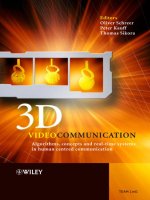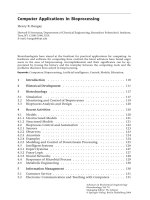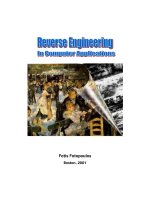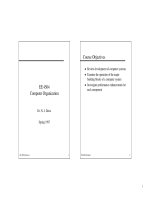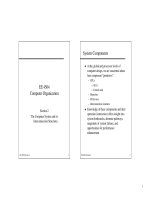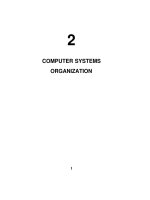Computer concepts chapter11
Bạn đang xem bản rút gọn của tài liệu. Xem và tải ngay bản đầy đủ của tài liệu tại đây (4.21 MB, 73 trang )
Chapter 11
Databases
Computer Concepts
2012
11 Chapter Contents
Section A: File and Database Concepts
Section B: Data Management Tools
Section C: Database Design
Section D: SQL
Section E: Database Security
Chapter 11: Databases
2
11 FastPoll True/False Questions
Answer A for True and B for False
110100 Predictive data entry produces data
warehouses and OLAPs.
110200 The simplest model for storing data is a flat
file.
110300 A fixed-length field contains field names and
record types.
110400 An ERD shows relationships and cardinality.
110500 The most popular business database model
is based on a relational database.
Chapter 11: Databases
3
11 FastPoll True/False Questions
Answer A for True and B for False
110600 Spreadsheet software is optimized for
working with relational data.
110700 Database software such as Microsoft
Access provides an option to produce HTML
formatted reports.
110800 XML is a database model that combines flat
files and relational database models.
110900 BLOB and SQL are data types.
Chapter 11: Databases
4
11 FastPoll True/False Questions
Answer A for True and B for False
111000 The goal of normalization is to reduce data
redundancy.
111100 Sorting a database is the same as indexing
it.
111200 Databases transmitted over the Web can be
encrypted using HTML.
111300 A database audit can sometimes identify
unauthorized intrusion attempts.
Chapter 11: Databases
5
11
SECTION
File and Database Concepts
A
Database Basics
Database Models
Chapter 11: Databases
6
11 Question
112100 The plots for several recent movies revolve
around the government’s use of what technology to
identify terrorists based on spending habits and
other data stored in commercial and government
databases?
– A. Predictive analytics
– B. Executive dashboards
– C. ERDs
– D. Data cubes
Chapter 11: Databases
7
11 Database Basics
A database is a collection of
information
– Typically stored as
computer files
The tasks associated with
creating, maintaining, and
accessing the information
in databases are referred to
as data management, file
management, or database
management
Chapter 11: Databases
8
11 Database Basics
Databases can be used in a variety of ways
– Collect and
store data
– Update data
– Organize and
output data
– Distribute data
– Find data
– Analyze data
Chapter 11: Databases
9
11 Database Basics
Data mining refers to the process of analyzing existing
database information to discover previously unknown and
potentially useful information, including relationships and
patterns
– Data warehouse
– Predictive analytics
Chapter 11: Databases
10
11 Database Basics
OLAP (online analytical processing) allows decision makers
to look for relationships between multiple
data dimensions
– Executive
dashboard
software
Chapter 11: Databases
11
11 Database Models
An unstructured file has a unique structure
A structured file uses a uniform format to store data
The underlying structure
of a database is referred
to as a database model
Chapter 11: Databases
12
11 Database Models
The simplest model for storing data is a flat file that consists
of a single, two-dimensional table of data elements
Chapter 11: Databases
13
11 Database Models
A field contains the smallest unit of meaningful information
Each field has a unique field name
Variable-length field vs. fixed-length field
Chapter 11: Databases
14
11 Database Models
A record is a collection of data fields
The template for a record is referred to as a record type
A record that contains data is referred to as a record
occurrence
Chapter 11: Databases
15
11 Database Models
A relationship is an association between data that is stored
in different record types
– Cardinality
• One-to-many
• Many-to-many
• One-to-one
Chapter 11: Databases
16
11 Database Models
Cardinality refers to the
number of associations that
can exist between two
record types
The relationship between
record types can be
depicted graphically with an
entity-relationship diagram
Chapter 11: Databases
17
11 Database Models
A hierarchical database arranges record types in a hierarchy
Chapter 11: Databases
18
11 Database Models
A network database uses a mesh-like structure to offer the
additional capacity to define many-to-many relationships
Chapter 11: Databases
19
11 Database Models
A relational database stores data in a collection of related
tables
Chapter 11: Databases
20
11 Database Models
A dimensional database organizes relationships over three
or more dimensions
Chapter 11: Databases
21
11 Database Models
An object database stores data as objects, which can be
grouped into classes and defined by attributes and methods
Chapter 11: Databases
22
11 Database Models
An object-relational database is
used to describe a variety of
technologies that combine objectoriented and relational concepts
Chapter 11: Databases
23
11
SECTION
Data Management Tools
B
Data Management Software
Database Management Systems
Databases and the Web
XML
Chapter 11: Databases
24
11 Question
112200 Most people have purchased merchandise
from Amazon.com and similar online stores. What
technology do these sites use to describe
merchandise and handle customer shopping carts?
– A. Static Web publishing
– B. Spreadsheet data management
– C. Server-side programming
– D. E-commerce client software
Chapter 11: Databases
25


